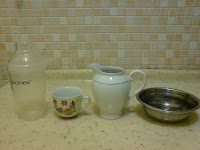The term volume of liquid refers to the measure of capacity. The term of capacity is used to measure of substances that can poured, that is, fluids. Capacity is measured in millilitres(ml) and litres (l) in the metric system. The volume of a container is generally understood to be the capacity of the container, i. e. the amount of liquid that the container could hold, rather than the amount of space the container itself displaces.
Year 2 Students always confused when comparing capacity of two containers that can hold more. The method to read and understand the measurement is very important.
When measuring the volume of a liquid it is important to remember that liquids often adhere to surfaces. Place some liquid in a graduated cylinder and look at the meniscis (where the liquid meets the air). Notice that the meniscis is bent such that the edges are higher than the center. To get an accurate measure of volume, read the middle (lowest point) of the meniscis. It is also important to have your eyes at the same level as the meniscis when reading the measurement.
Below teaching aids and teaching activities (for high achiever and lower achiever students respectively) will help Year 2 students to understand better on volume of liquid.






